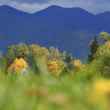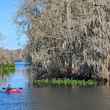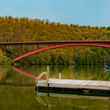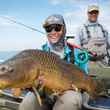Some years ago, while working as a newspaper journalist in the mountains of Colorado, I remember having an epiphany that I couldn’t help but include in a piece I did for the paper on fall fly fishing. At the time, we were enjoying a really nice Indian summer — we had a blustery start to September and then, as things are prone to do in the southern Rockies, those perfectly blue and cloudless skies came back, along with warm temperatures and that flawless golden hue that graces the aspens and the cottonwoods of the West every autumn.
This is perhaps the best time of the year to be a fly fisher, even if fall is a harbinger of winter — and I hate winter these days. These bright, sunny days are ideal for anglers looking to spend one more day or one more weekend in the high country chasing trout that are just too damned willing for their own good.
As I knelt by a beautiful little mountain creek that flows off the shoulders of the Sawatch Range in the Arkansas River drainage, I remember cradling a palm-sized brook trout that came to hand after absolutely crushing a size 12 Royal Coachman (it was my go-to attractor back in the day). I remember thinking, “Damn. There’s nothing prettier than a September brook trout. Except maybe an October brook trout.”
I included that phrase in my weekly newspaper column for the Mountain Mail, a Salida daily that’s still chugging along today, only to be scolded by some die-hard local anglers who thought it was improper to be telling the paper’s readership about the “secrets” of fall fishing in the surrounding mountains.
“It’s hunting season,” one reader wrote. “Let the hunters think that the fishing is done for the year, and let everyone else think that the mountains are so overrun with the hunters that anglers are likely to be shot.”
Regardless of the backlash, I stand by my epiphany. The invasive little char from the spine of Appalachia really puts on a show come fall. And while they don’t belong anywhere near the creeks and streams of the Rockies, they do their best to celebrate the season. Fall spawners, when they color up and get busy on the redds, brookies are the most beautiful salmonid on the planet. Prove me wrong.
Say what you will about fall’s kype-jawed, butter-tinged browns — a monarch of any river or stream anywhere it swims — the diminutive brook trout and its inexplicably perfect blends of orange, blue, creamy white, deep red and olive green is a sight to behold.
And the life force of a brook trout is arguably the most acute among wild fish that swim the waters of America. The fish is relentless and exuberant, no matter where it swims. It’s the Capt. Jason Nesmith of the salmonid family. Never give up. Never surrender.
That may be why you’ll find brook trout in waters where you won’t find much else. First, to be clear, that’s not necessarily a good thing. Brookies have wreaked havoc on the West’s native trout, particularly cutthroat trout. Where they were introduced — sometimes well over a century ago — they outcompeted the native fish and have largely taken over the coldest, most austere trout habitat in the Rockies.
Unfortunately, that habitat is also where native cutthroats spawned every spring and, in some remote drainages, it’s where they thrived in the habitat in which they evolved. But the introduction of the brook trout might be the single-biggest factor responsible for the demise of native cutthroat trout populations in the West. Our native fish now hang on in about 10 percent of their native ranges, from the Rio Grande cutts of the Southwest to the west slopes of Rockies north into southern Canada.
Certainly, one could argue that transplanted rainbows from the coastal rivers and streams of the West Coast have done a number on native cutthroats — the two fish can mingle on spawning redds and produce a fertile hybrid. But I would argue that brookies were a more potent addition to the western trout cocktail. They didn’t slowly breed the cutthroats out of existence. They ate their competitors out of house and home, making perfectly habitable waters for cutthroats completely unlivable.
Many biologists credit that fact to the fall-spawning regime of brook trout and the spring spawning of cutthroats. By the time cutthroats are digging redds and laying eggs, brook trout fry are emerging from the gravel and going after the very same food sources the little cutthroats will need later in the year, when they emerge. In short, the cutthroat fry emerge into a world where food is hard to come by.
And brookies are their own worst enemies. In most of the waters where they’ve become naturalized, they’ve exhausted the edible resources. While they still spawn prolifically, they tend to stunt and grow only to the limits their habitat can support. That’s why when you hear the words “brook trout,” you also hear accompanying adjectives, like “little,” “tiny.” For most western anglers, brookies are simply not worth the effort.
But even I, being profoundly appreciative of native trout, can still find value in chasing brook trout. If I’m lucky enough to find a few that have grown longer than six inches long, I’ll readily harvest the fish. In my opinion, they’re the best-tasting wild fish in the water, even if it’ll take a half a dozen to make a meal. And I’m not alone.
A friend of mine, as I was matriculating through my journalism career in Colorado, was quick to harvest every brook trout he caught, regardless of size. He’d take the fish home, gut them and remove the heads, and then he’d pressure-can them in Mason jars, like sardines.
“Beats the hell out of tuna salad any day,” he said. And, on more than one occasion, I sampled his canned brookies, served with salt and pepper on a soda cracker. Delicious.
‘Tis the season for beautiful brook trout. Even if your motivation is to simply light up the viewfinder of your camera or the screen of your phone with the prettiest of all the trout and salmon, chasing backcountry brookies is an adventure. And while you appreciate the gorgeous, colorful hues that grace the fish that hit your fly, look up and look around once in a while.
The golden aspen and willow leaves are just as stunning as the fish that makes a fall fly-rod trip absolutely worth it. Especially in October.
































Comments
John M replied on Permalink
To quote a fly fishing minister I once new, "brook Trout ate the most beautiful fish in God's creatuon". But back here in the Adirondacks and much of the rest of the brook trouts native range your estern rainbows and Europe's brown trout have out competed and reduced the brook trout to just a very small portion of its native range, especially in there native lakes and ponds. I cherish what is left of the native rookies in their true habitat.
John Duncan replied on Permalink
I lived in George, Oregon, near Estacada, and just southwest of Portland, on the Clackamas River, on an acreage just above Eagle Creek; which runs into the Clackamas. Eagle Creek is a native Brook trout run, that Zane Grey traveled to as often as he could in-between books to fish for his favorite Browns. Eagle Creek is beautiful, wild, and natural...the water--crystal clear, flowing through evergreen forest west from the foothills of the Cascades into the watershed that feeds into the Willamette River, Columbia, and the Pacific. Oregon law requires a buffer zone at water's edge; so, even though the hills above Eagle Creek are heavily logged, this native Brook Trout run is still shaded and protected.
Bryce replied on Permalink
You are a total d bag. Just stop
Pages